
home I index I latest I glossary I introductions I e-mail I about this site
499: St Nicholas, Kings Lynn
Read
the captions by hovering over the images, and click on them to
see them enlarged.
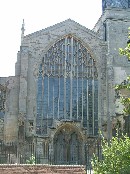
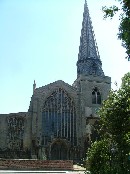
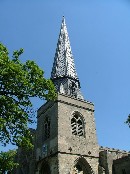
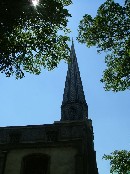
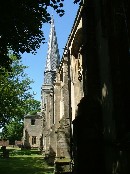
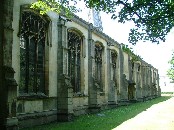
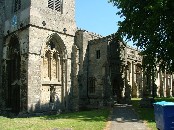
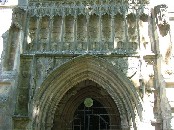
St
Nicholas, Kings Lynn
But just off of the Tuesday Market, in the part of town known as the Northend, there is St Nicholas. It sits in its peaceful, tree-lined setting, lifting George Gilbert Scott's 19th century spire above quiet yards, inns, banks, hotels and the jaunty Corn Exchange. This vast hall of a church, some 200 feet long, was, incredibly, built as a chapel of ease to St Margaret, and even today is styled 'St Nicholas Chapel'. If you exclude Cambridge's Parker's Piece, which is surely too big to be considered, then the Tuesday Market in Kings Lynn is East Anglia's largest urban square, a dreamy lozenge of 18th and 19th century architecture. It surprises me that it is not better known, although the tourist industry is really beginning to gear up in Lynn. This is partly because it is a designated area of deprivation, its old industries struggling to employ the people that they once did. Consequently, there is a smell of European money, the whole town is undergoing a face-lift, and the museums are of the highest quality. And, it must be said, the people are really very friendly indeed, as if they appreciate your interest. Everywhere, in museums, shops and pubs, people go out of their way to help you. If you are fed up with being treated like dirt by the tourist industry in Cambridge, come forty miles north and spend your money here instead. True's Yard, the museum of the fishing industry, sits just to the north of St Nicholas, and it is here that you collect the key. It is worth noting that St Nicholas has been redundant these last thirty years, and is in the care of the Churches Conservation Trust. Because of this, it is often in use for concerts and performances, and it is really worth ringing up the museum first to ask if access is possible before visiting. They prefer not to give out the key if the church is full of musical instruments or electronic equipment. But the museum workers are as friendly as everyone else, and clearly know and love the church well.
The rebuilding of St Nicholas as a huge Perpendicular hall church happened surprisingly early; in a bequest of 1419 it is already being referred to, as de novo edificato ('newly built'), which makes it increasingly certain that no new tower was planned. The tower itself must be two hundred years older, and the only surviving traces of the church that predated it are on its eastern face inside the church. This is one of the biggest of the churches in the care of the Churches Conservation Trust. Of their churches in East Anglia, only Bungay St Mary begins to approach it in size. Churches this big don't respond to the CCT aesthetic as much as smaller ones; the clearing of clutter and stripping away of 20th century compromises which creates such a sense of quiet spirituality in a small church can leave a big one looking rather empty and sterile. But St Nicholas is more than an architectural wonder, because there are some fascinating details to ponder. And so, you step through the arcade into the body of the nave, and the true magnificence of the building reveals itself, under a glorious late medieval angel roof. Before exploring you probably need to get over the great weakness of the interior. This is the vast acreage of mediocre 19th century pews, shoehorned under the arcades during John Brown's 1850s restoration. They are heavy and dull, a poor thing compared with the great roof overhead. I suppose that there must be some historical or financial reason for keeping them, but how good it would look if they could be removed and replaced with modern chairs, perhaps leaving the aisles empty. You walk through them to encounter one of Norfolk's more surprising fonts. It is on a built up set of octagons panelled with flushwork, is decorated with strapwork, and bears the date 1627. There are several local fonts of about this date - Gaywood and Tilney All Saints spring to mind - but this one is singular because it may well have been the first font this building ever had. St Nicholas was granted a licence to perform baptisms as early as the 1370s, but it appears that it did not do so, and instead they were carried out in the mother church, St Margaret. In the 1620s, Bishop Harsant of Norwich donated the font, and the font records his gift in an inscription on the eastern face. However, the pedestal appears contemporary with the rebuilding of the church two hundred years earlier, and so one must always have been intended. In the north-west corner, beyond the font, some benches have been cobbled together around a table. At first, this might appear like a modern attempt at some kind of meeting area, but it appears to have been put together much earlier, and was probably some kind of consistory court. There is very little old woodwork remaining - some is here, some is in the east end of the south aisle, some in the sanctuary. But in fact, there were some spectacular bench ends at St Nicholas, which for no accountable reason are now in storage at the Victoria and Albert museum in London. They should be returned here forthwith. The east window above, by Ward and Hughes, is better. It depicts 32 scenes from the life of Christ, starting in the bottom left hand corner with the Annunciation and then weaving a wandering path around the huge expanse. Elsewhere, there is a fine depiction of Mary of Magdala finding the empty tomb. It is half way down the south aisle, including a little technicolour calvary towards the top, a curious touch.
Striking in the vastness is the brightly coloured sword rest in the south arcade. It is dated 1743, 1760. As I said, large CCT churches can sometimes appear rather bare, but St Nicholas is rescued from austerity by its wide range of memorials, probably the best collection in west Norfolk. They are all very brightly coloured, the result of a restoration in the late 1970s. They are all worth a look. The 1620s Clarck father and son memorial on the east wall of the south aisle is very striking; it shows them either side with their wives, Matthew Clarck's side being delightfully crowded with nine children bustling around him and his wife. Beneath, the figure of his first wife sleeps, and across the top it says Vita Nobis Christus, Mors Nobis Lucrum ('Our life is in Christ, Death is our reward'). Simon Knott, June 2006 |
Amazon commission helps cover the running costs of this site.
home I index I latest I introductions I e-mail I about
this site I glossary
Norwich I ruined churches I desktop backgrounds I round tower churches
links I small
print I www.simonknott.co.uk I www.suffolkchurches.co.uk